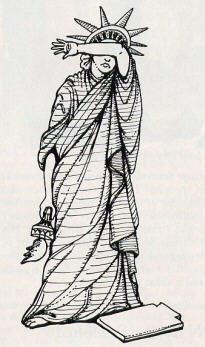
Every morning, weather permitting, around half past five I take my morning constitutional, chanting quietly on my beads as I walk from our Brooklyn Radha-Govinda Temple on Schermerhorn Street down to the Brooklyn Heights Promenade. There under the locust trees I sit on a certain bench with a view that commands most of New York Harbor, and I silently chant the Gayatri mantra. Before me rises Manhattan's burnished skyline. To my left lies Governors Island. And beyond although this morning only a specter in the mist stands the Statue of Liberty, lifting her golden lamp beside the "golden door." My grandparents, like other Eastern European immigrants at the turn of the century, passed through the portals of Ellis Island under the benign eyes of Lady Liberty. For them the American icon stood for freedom, equality, and opportunity. A lot to stand for. But now, with the Lady's hundredth birthday and all the commercialization that has inevitably followed, she's having to stand for an awful lot more.
Sad to say, Lady Liberty has become exploited. From silver Tiffany teaspoons to silk-screened T-shirts, from Erte sculptures to foam rubber Lady Liberty halos and torches, from the statue sculptured in ice to chopped-liver molds from the sublime to the ridiculous.
Since funding for the restoration of the statue has come from the private sector, many of the sponsoring patrons have used the Lady to hawk their products. Advertisements have shamelessly shown Lady Liberty brandishing not only her beacon lamp but an ice cream cone, a pizza, a platter of chicken, and a Whopper!
What would Frederic Bartholdi, the sculptor, or Emma Lazarus, the poet who wrote "I lift my lamp beside the golden door," have thought to see Lady Liberty lifting a platter of chicken parts or displaying the effectiveness of an underarm deodorant?
The lamp that was once a beacon of freedom and opportunity now seems to convey a different message. The liberty the Lady now represents is no longer freedom from want, as might be indicated were she holding, say, a loaf of bread. But with the Statue of Liberty holding forth promises of junk food, we step beyond simply having enough to eat into the realm of decadence. For today's immigrant, America promises not simply freedom from hunger, but gluttony and unbridled sensuality.
For example, just a few days before Liberty Weekend the U.S. Supreme Court ruled that a Georgia law criminalizing sodomy was constitutional. As was to be expected, gays across the country were outraged, seeing the Supreme Court decision as an infringement of their right to the private pursuit of happiness. Angry gays saw themselves left out of the liberty pie. As one gay-rights handbill put it, "We are being denied the very rights this Liberty Weekend is meant to celebrate."
But exactly what are our inalienable sexual rights? The sex urge is natural, and the Vedic literature explains that the sexual rights and responsibilities of human beings are to be exercised within marriage. The sex act, therefore, is primarily for procreation. Unrestricted sex (which includes homosexuality) increases the illusion of bodily identity. Sex desire is like an itch: the more you scratch it, the worse it gets.
By coincidence, I recently came across an advertisement: "Freedom from itch with Atarax." The ad showed (you guessed it) the Statue of Liberty scratching her back. Taking the itch to be the desire for sense enjoyment, this is an unwittingly apt depiction of modern America's freedom to pursue happiness: the freedom to increase the itch of sense gratification.
Under the illusion of maya, people generally think that freedom means to be able to do as they want, giving in to whatever whim and temptation their mind subjects them to. But for one on the path of self-realization, freedom means to master desires, not to serve them to cure the itch, not to aggravate it by repeated scratching.
Krsna consciousness enables anyone to control the tongue, subdue the sex impulse, and quell other mundane desires. Although desires will not automatically cease, by experiencing the higher taste of Krsna consciousness one can learn to tolerate the urges of the senses and to engage the senses in the higher spiritual activity of serving Krsna. One in Krsna consciousness gives up the illusory freedom of unrestricted sensual enjoyment for the greater freedom of liberation from this world of repeated birth and death.
